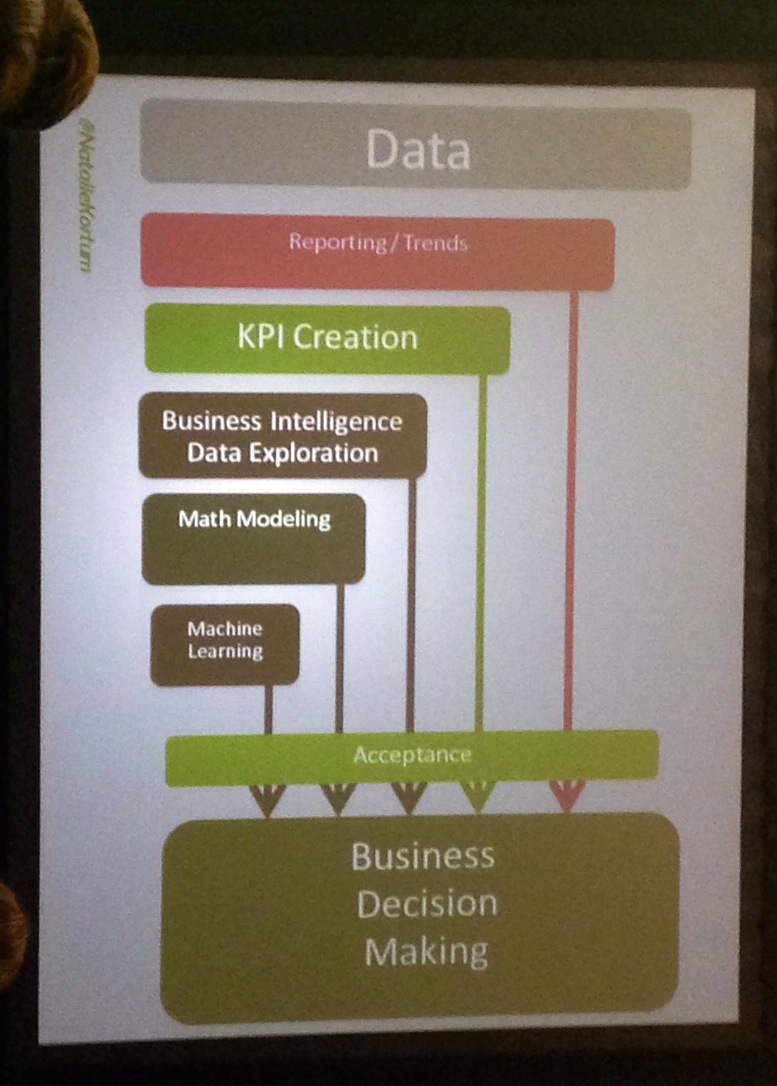The first session of SMX West started with what’s an afterthought for too many content marketers: Making decisions based on data. Two of the starting speakers highlighted how everyone (think: Users and businesses) benefits from data-driven decisions. First up, Cindy Krum of Mobile Moxie, spoke about why mobile is the most untapped resource of user behavior insights, followed by Natalie Kortum of Humana on how to create a culture of metrics-led thinking.
Mobile data is power
Think 2014 is the year brands will master content marketing? What about creating content for small screens? With mutli-device brand engagement already mainstream, the majority of attendees admitted they don’t feel confident they’re making the most of their mobile data. Cindy spoke of five stages in mobile analytics that companies should get behind:
- Understanding. What’s trackable?
- Mining. Where is the data across devices (or analytics platforms)?
- Merging. What’s the story from different numbers?
- Sharing. Who else needs this information to make good decisions?
- Selling. Can the stats be sold for other companies’ ad revenues, and how?
Knowing where to get started is tricky. Unless information is stored in the cloud, it gets locked into specific devices.

This is where apps can come in handy: They allow information to be dispersed across devices. On a well crafted slide about NSA regulations, Cindy highlighted the difference between what’s tracked for mobile apps versus web apps, when you get permission.
Mobile Apps:
- Elements of the OS
- In-app submissions
- In-app purchases
- Time/location/device
- Web interaction
Web Apps:
- Web submissions
- Downloads/purchases
- Time/location/device
The takeaway may be that business in a position to create mobile apps for users (platforms that are well marketed and useful enough to earn buy-in) stand to gain otherwise hidden data. And more data is power when it comes to marketing results.
Cindy also shared insights on where to find data, beyond proprietary analytics platforms. (Notably, on the website side, Google Analytics can show which devices and operating systems are used for interaction with a site.) There are a number of free mobile data resources that can be useful:
About half of traffic to adult sites comes from mobile … People use phones in unexpected ways, and understanding the mobile user and her behavior is now a marketing must.
- The World Bank
- Data.gov
- Open Data Institute
- EU Open Data initiatives
- Code for America
- National Weather Service
- The Sunlight Foundation
- The Open knowledge Foundation
Ultimately, she pointed out it’s essential to know what you can track, to get permission and gather as much as you can. Then, figure out how to cross your information with other data sets and think of ways to merge and share it with the right players for smarter marketing – or monetize it.
Still not convinced that mobile is where it’s at? Cindy shared a fun (disturbing?) tidbit – half of traffic to adult sites is now from mobile devices. People use their phones for more than marketers may think.
Understanding the mobile user and her behavior is now a marketing must.
Moving from (cross-web) data to business decisions
With these insights on how and why to track mobile data front-of-mind for SMX West attendees, Natalie Kortum took the stage to explain how to leverage it. As she explained, there is a business decision that needs to be made on one end of spectrum, and on the other end is a mound of data. What’s in between?

Natalie outlined five phases of data use, explaining it’s critical for a marketer to get buy-in from the business, product or brand decision maker at each step.
- Reporting on trends. This is initial data organization that creates high-level insights.
- Key performance indicators. KPIs are the stage where marketing efforts (like content types or channel efforts) are held accountable to goals.
- Business intelligence. At this phase, KPIs are examined with an eye for why business decisions have been made in the past, or how they should be evaluated for the future.
- Math modeling. This involves evolving a marketing strategy or a business model based on analysis of what the data shows.
- Machine learning. Once a company hits machine learning, it’s making actual choices about marketing based on user behavior surmised from data – perhaps even in an automated way.
Gaining trust in data: A quick guide for marketing strategists & analysts
Moving through the data-to-decision pathway requires that the “boss” or ultimate decision maker accepts what the numbers outline. So what breeds success for the ongoing analytics, the data that gets continued buy-in for strategic decision making?
Natalie shared best practices for data analysts to communicate their findings:
Meet a strategic business need.
First, ask what this person wants to tell her manager? Be prepared to put the data in conversation with the ultimate goals (not the KPIs).
Explain the analytics in a way business people* can understand.
*Non-technical, as in they won’t know research language or Analytics jargon. Natalie advised walking the information past a non-technical supporter. Find someone who isn’t on the marketing or data analysis team to “talk at,” and get candid feedback on what is clear (or what is not). While it’s important not to talk down to executives, she also recommended preparing a presentation as if the audience was a relative not in the industry, or even a 10-year-old student.
Another pro tip? For the big data nerds, explain methodologies in less than two minutes and use analogies.
Demonstrate ROI
Finally, create proof of technique and avoid talking about assumptions. Instead of focusing on KPI numbers. Aim to map these to final business revenue. Marketers should aspire to get to the point where the one managing the strategy is the stakeholder, and trusted to make the budget decisions.
More great tips to come from SMX West, and learn more about smart marketing analytics, and when your content metrics fail you.




